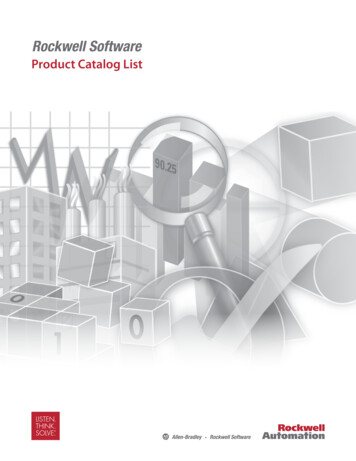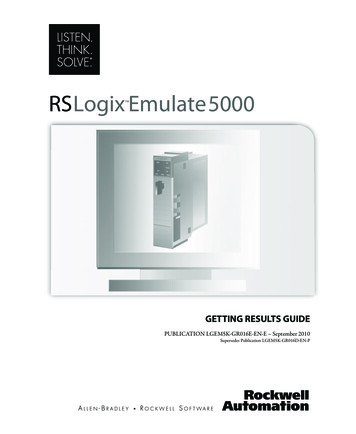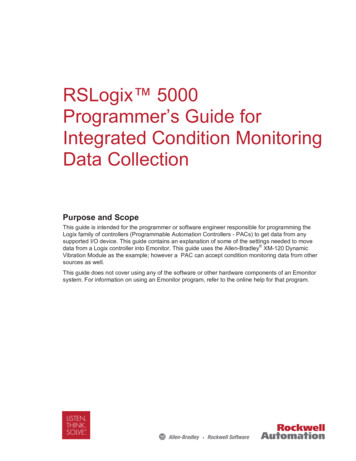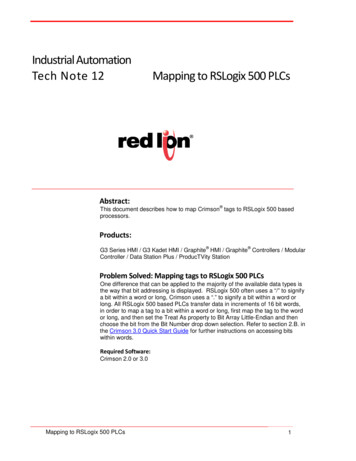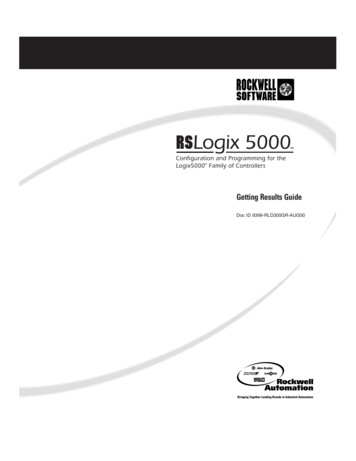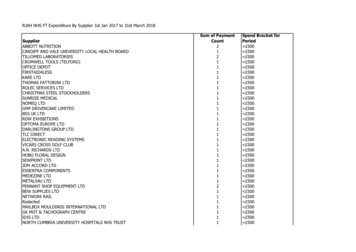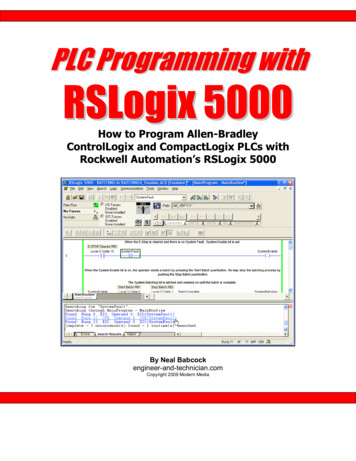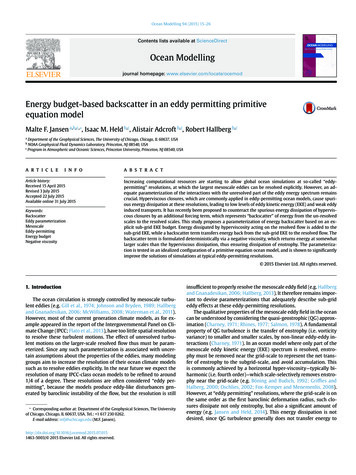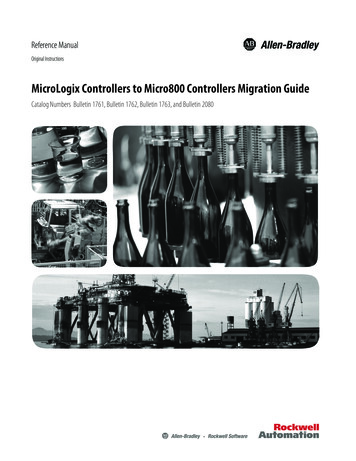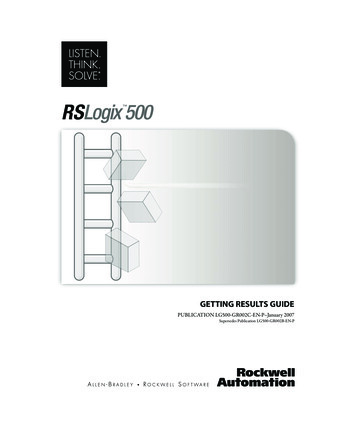
Transcription
LG500 GR002C-EN-P1/23/083:28 PMPage 1RSLogix 500 GETTING RESULTS GUIDEPUBLICATION LG500-GR002C-EN-P–January 2007Supersedes Publication LG500-GR002B-EN-P
Contact RockwellCustomer Support Telephone — 1.440.646.3434Online Support — http://support.rockwellautomation.comCopyright Notice 2007 Rockwell Automation Technologies, Inc. All rights reserved. Printed in USA.This document and any accompanying Rockwell Software products are copyrighted by Rockwell AutomationTechnologies, Inc. Any reproduction and/or distribution without prior written consent from Rockwell AutomationTechnologies, Inc. is strictly prohibited. Please refer to the license agreement for details.Allen-Bradley, FactoryTalk, Rockwell Automation, Rockwell Software, RSLinx, RSView, and the Rockwell Softwarelogo are registered trademarks of Rockwell Automation, Inc.Trademark NoticesThe following logos and products are trademarks of Rockwell Automation, Inc.:RSLogix.Advanced Interface (A.I.) Series, A.I. Series, Data Highway Plus, DH , RSView.FactoryTalk Activation, FactoryTalk Administration Console, FactoryTalk Automation Platform, FactoryTalkDirectory, RSAssetSecurity, FactoryTalk Security, and RSSql.MicroLogix, RSLinx Classic, RSLinx Enterprise, SLC 5, and SLC 500.Other TrademarksActiveX, Microsoft, Microsoft Access, SQL Server, Visual Basic, Visual C , Visual SourceSafe, Windows, WindowsME, Windows NT, Windows 2000, Windows Server 2003, and Windows XP are either registered trademarks ortrademarks of Microsoft Corporation in the United States and/or other countries.Adobe, Acrobat, and Reader are either registered trademarks or trademarks of Adobe Systems Incorporated in theUnited States and/or other countries.ControlNet is a registered trademark of ControlNet International.DeviceNet is a trademark of the Open DeviceNet Vendor Association, Inc. (ODVA).Ethernet is a registered trademark of Digital Equipment Corporation, Intel, and Xerox Corporation.OLE for Process Control (OPC) is a registered trademark of the OPC Foundation.Oracle, SQL*Net, and SQL*Plus are registered trademarks of Oracle Corporation.All other trademarks are the property of their respective holders and are hereby acknowledged.WarrantyThis product is warranted in accordance with the product license. The product’s performance may be affected by systemconfiguration, the application being performed, operator control, maintenance, and other related factors. RockwellAutomation is not responsible for these intervening factors. The instructions in this document do not cover all thedetails or variations in the equipment, procedure, or process described, nor do they provide directions for meeting everypossible contingency during installation, operation, or maintenance. This product’s implementation may vary amongusers.This document is current as of the time of release of the product; however, the accompanying software may havechanged since the release. Rockwell Automation, Inc. reserves the right to change any information contained in thisdocument or the software at anytime without prior notice. It is your responsibility to obtain the most current informationavailable from Rockwell when installing or using this product.Version: 7.30.xx (CPR 7)Modified: June 28, 2007 9:02 amii
PrefacePurpose of this bookThis Getting Results book provides you with information on how to install andnavigate the RSLogix 500 software. This guide includes troubleshootinginformation and tips on how to use RSLogix 500 effectively. It also explainshow to access and navigate the online help.Intended audienceWe assume that you are a control engineer familiar with: IBM-compliant personal computers Microsoft Windows 2000 , Windows XP ,Windows Server 2003 , orWindows Server 2003 R2.Rockwell Automation’s SLC 500 and MicroLogix families of controllersDocument conventionsThis manual uses the following typographical conventions: [Bold] characters in brackets represent keystrokes used to execute afunction. When more than one key is to be pressed at a time, the keys areseparated by a plus sign. For example, [Ctrl v] means hold down the[Ctrl] key and press the [v] key. Bold characters represent menu choices. TEXT IN THIS FONT represents characters that you should type.Online helpIf you need help while using RSLogix 500, use any of the following methods: choose Help from the menu bar click the Help button on any RSLogix 500 dialog press [F1] on any instruction, dialog box, or window view.For more information about the online help refer to RSLogix 500 online help onpage 91.Prefaceniii
TrainingRockwell Software offers both classroom training and a computer-basedtraining program for RSLogix 500 software. For more information see RSLogix500 Training on page 95.Commonly used termsThe following table defines terms commonly used in this book.ivnThis term:Represents this concept:activation filesHidden files in the root folder that allow the software to run. Thesoftware checks for these files before you have access to offlineor online programmingback upTo make a copy of the current file before replacing that file withan updated version.downloadRestore a specified file to a specified processor. For example,when you download the current project file, you copy the file toa specified processor so the processor can begin running that file.libraryA file into which you store or from which you retrieve portionsof ladder logic.mnemonicA term, usually an abbreviation that is easy to remember. SLCinstructions are typically represented by a 3-letter mnemonic.projectAll of the files that make up the SLC 500 logic program includingthe documentation files.uploadAccess an SLC processor and save a copy of the project.verificationAn analysis of the ladder program files that results in the displayof any programming errors.zonePortion of the ladder logic identified by a marker indicating theedited state of the file.Getting Results with RSLogix 500
ContentsPreface . iiiPurpose of this book .iiiIntended audience .iiiDocument conventions.iiiOnline help.iiiTraining.ivCommonly used terms .ivChapter 1Installing RSLogix 500. 1Introduction .1System requirements.1Hardware requirements.1Software requirements .2Activation .2Installing RSLogix 500 software .3Installing RSLinx Classic Lite software .3Installing the FactoryTalk Automation Platform.4Installing the FactoryTalk Activation Client.6Installing the Security Server Client .8Installing RSLogix 500 .9Upgrading the FactoryTalk Platform .11Upgrading a Stand-Alone System on a Single Computer . 11Upgrading a Distributed FactoryTalk System on a Network . 12Importing a Security Configuration from the Rockwell Software Security Server intoFactoryTalk Security .15Configuring FactoryTalk Security for RSLogix 500 .16Setting Security Policies for RSLogix 500 . 17Securing Actions for RSLogix 500 . 20Starting RSLogix 500 software.28Troubleshooting installation.28Table of Contents v
Chapter 2Getting started with RSLogix 500 .31Welcome to RSLogix 500. 31Exploring RSLogix 500 . 32Quick Start Steps . 33Step 1 Step 2 Step 3 Step 4 Step 5 Step 6 Step 7 Step 8 Step 9 Step 10 Step 11 Step 12 Configure a driver in RSLinx Classic. 34Configure system communications. 36Create a new project or open an existing project . 38Create program and data table files . 40Define chassis and modules. 41Enter a logic program . 41Add documentation to your logic instructions . 43Validate your project . 44Configure communication channel, download and go online. 45Monitor data files. 45Search and replace instructions . 46Print a report . 47Chapter 3Chassis and module setup .49Power supply loading . 50Analog and specialty module configuration . 50Automatic I/O configuration. 50Chapter 4Entering ladder logic.51Backing up your work. 51Crash Recovery. 52Quick entry of instructions . 53Addressing . 54Branching. 55Add a branch . 55Move a branch . 55Expand a branch . 55Nested branches. 55Parallel branches. 55Copy branch leg. 56Copy entire branch structure. 56vi Getting Results with RSLogix 500
Delete a branch . 56Branching restrictions . 56Undo operation .56Online editing .57Lower case zone markers. 58Upper case zone markers. 58Online editing example . 59Online editing restrictions . 60ASCII editing .60Configuring interrupts.60Selectable Timed Interrupt . 61Discrete Input Interrupt . 61Chapter 5Importing or exporting the documentation database . 63Introduction .63Import database.63A.I. project documentation database . 64APS project documentation database. 64RSLogix 500 documentation database. 64CSV (Comma Separated Values) file . 64ASCII delimited text file . 65Export database.65RS500 ASCII delimited text file examples. 66A.I. ASCII delimited text file examples. 67Chapter 6Monitoring data. 69Introduction .69Multipoint Monitor.70Forces.70Custom Data Monitor (CDM) .71Custom Graphical Monitor .71Recipe Monitor.72Trends .73Histograms .73Data Logging (MicroLogix 1500LRP only) .74Cross Reference.75Table of Contents vii
Chapter 7Saving and loading SLC libraries .77Introduction. 77Exporting libraries . 77Importing libraries . 78Chapter 8Features in RSLogix 500 Professional.81Microsoft Visual Basic for Applications support . 81Custom Graphical Monitor. 81Editing project databases using Microsoft Excel . 82Logic Trace . 83How logic trace works. 83Appendix AEVMOVE Activation.85Chapter BGetting the information you need.91Introduction. 91RSLogix 500 online help . 91Opening an expandable table of contents. 92Index. 92Find. 92Learning RSLogix 500 step-by-step. 93Quick tips about Windows operating systems and RSLogix 500. 94Keyboard shortcuts . 94User Application help . 94Instruction Set help . 95RSLogix 500 Training . 95Classroom training . 95Interactive training . 96Technical support services . 96When you call . 97Index.99viii Getting Results with RSLogix 500
1Installing RSLogix 500ChapterIntroductionThis chapter explains how to install and start RSLogix 500 software. Thischapter includes information on the following: system requirements installation methods activation overview and methods installation and activation procedures starting procedures troubleshooting installation and activationAfter installing the software, we recommend that you read the release notelocated in the online help. The release note may contain more up-to-dateinformation than was available when this document was published. To view theRelease Notes, start the RSLogix 500 software; then choose Help RSLogixRelease Notes.ImportantIf you are installing RSLogix 500 on a computer running Windows2000 , Windows XP , Windows Server 2003 , or WindowsServer 2003 R2, you must have administrator privileges for thecomputer to install RSLogix 500. For more information, contactyour system administrator.System requirementsTo use RSLogix 500 effectively, your personal computer must meet thefollowing hardware and software requirements:Hardware requirements an Intel Pentium II or greater microprocessor128 MB of RAM for Windows NT, Windows 2000, or Windows XPinstallations (64 MB for Windows 98 installations)Installing RSLogix 500 1
45 MB of available hard disk space) 256-color SVGA graphics adapter with 800x600 resolution a CD-ROM drive any Windows-compatible mouse or other pointing deviceWe recommend a 500-MHz Pentium computer with 128MB RAM or greaterfor optimal performance.Software requirementsThe operating system must be one of the following: Microsoft Windows 2000 Windows XP (with or without Service Pack 2) Windows Server 2003 (with or without Service Pack 1) Windows Server 2003 R2RSLogix 500 will not run on earlier versions of Windows, nor will it run onWindows Vista. RSLogix 500 relies on RSLinx Classic communication software, version2.51.00 or later. One copy of the RSLinx Classic Lite software is includedwith the RSLogix 500 software.ActivationSoftware activation is a process by which you identify that you have installed alegitimate copy of RSLogix 500 on your computer. Activation works throughan activation file that indicates to the software that you are using the softwarelegitimately.There are two forms of activation supported by RSLogix 500: EVMOVE activation, which uses a master disk to deliver an activation fileto your computer FactoryTalk Activation, which allows you to download an activation filethrough an Internet connectionFor new installations of RSLogix 500, you must use FactoryTalk Activationto activate the software.2 Getting Results with RSLogix 500
If you are upgrading a current installation of RSLogix 500, you may continueto use your EVMOVE activation. However, future versions of RSLogix500 will require you to use FactoryTalk Activation. Rockwell Softwareadvises you to activate your software using FactoryTalk Activation now.TipFuture versions of RSLogix 500 will require using FactoryTalkActivation to activate the software. Rockwell Software stronglysuggests that you activate your software with FactoryTalk Activationnow to prevent difficulties with future versions of the software.Installing RSLogix 500 softwareInstalling RSLogix 500 software involves installing and configuring thefollowing software packages: Installing RSLinx Classic Lite software (if you do not have RSLinxClassic already installed on your computer) Installing the FactoryTalk Automation Platform (if you intend to useFactoryTalk Security to control access to features of RSLogix 500 – in thiscase, you will also need to configure FactoryTalk Security to allow users toaccess the software).Installing the FactoryTalk Activation Client (if you have a new RSLogix500 installation or need to upgrade your activation to FactoryTalkActivation. If you intend to continue using EVMOVE activation for now,you do not have to install this software.)Installing the Security Server Client (if you intend to use the RockwellSoftware Security Server to control access to features of RSLogix 500 – inthis case, you will also need to configure your Security Server to allow usersto access the software. Rockwell Software advises that you use FactoryTalkSecurity instead of the Security Server to provide security functions)Configuring FactoryTalk Security to permit access to features of RSLogix500RSLogix 500 softwareInstalling RSLinx Classic Lite softwareIf you have RSLinx RSLinx Classic Lite provides communication between the programmableClassic 2.51 or controller and a personal computer.later installed, youdo not need to To install RSLinx Classic Lite software:install RSLinxClassic Lite. 1. Log onto the computer as an administrator or as a user withadministrative privileges.Installing RSLogix 500 3
2.Insert the RSLogix 500 CD-ROM into the CD-ROM drive. Theinstallation program should start automatically. If it does not, open theinstallation disk with Windows Explorer and run AUTORUN.EXE.3.Click Required Steps, and then click Install RSLinx Lite.4.Follow the directions that appear on the screen.Installing the FactoryTalk Automation PlatformCautionTipIf you are upgrading the FactoryTalk Automation Platform, seeUpgrading the FactoryTalk Platform on page 11 for importantinformation.The FactoryTalk Automation Platform is required for usingFactoryTalk Security with RSLogix 500. It does not serve any otherpurpose with regard to RSLogix 500, however, it is used with avariety of other Rockwell Software products.If you have already installed the FactoryTalk Automation Platformfor the current release (the CPR number indicates the release), youdo not need to install it again.To install the FactoryTalk Automation Platform:1. Log onto the computer as an administrator or as a user withadministrative privileges.2.Insert the RSLogix 500 CD-ROM into the CD-ROM drive. Theinstallation program should start automatically. If it does not, open theinstallation disk with Windows Explorer and run AUTORUN.EXE.3.Click Required Steps, and then click Install FactoryTalk Components.4.Click Install FactoryTalk Automation Platform.5.Follow the on-screen instructions to install the FactoryTalk AutomationPlatform, keeping in mind the following key points: You must uninstall all Rockwell Software products that depend onFactoryTalk before uninstalling and reinstalling the FactoryTalkAutomation Platform on the same computer.The FactoryTalk Automation Platform, and all of the FactoryTalkenabled software products participating in the same automation system,must be part of the same Coordinated Process Release (CPR). Toupgrade to FactoryTalk Automation Platform 2.10.00, all participatingsoftware products must also be upgraded to versions that support CPR9.4 Getting Results with RSLogix 500
For a networked automation system, upgrade the computer hostingthe Network Directory Server first, and then upgrade the clientcomputers on the network.After installing the FactoryTalk Automation Platform, a FactoryTalkDirectory Configuration Wizard runs and prompts you to configure aFactoryTalk Directory. Configure the type of directory required by thesoftware products you plan to use and the type of automation systemyou plan to run: either a FactoryTalk Network Directory or aFactoryTalk Local Directory.The FactoryTalk Directory Configuration Wizard may prompt you tocreate an administrator account for each directory that you configure.Write down the user name and password that you enter, and keepthis information in a safe place. Remember that the password is casesensitive. You will need these credentials later to access the FactoryTalkDirectory and to log on to the FactoryTalk Administration Console.The FactoryTalk Directory Configuration Wizard prompts you to allowall user accounts or only administrative accounts initial access to theFactoryTalk Directory. If you plan to use FactoryTalk Security, choose"onl
RSLogix 500 will not run on earlier versions of Windows, nor will it run on Windows Vista. RSLogix 500 relies on RSLinx Classic communication software, version 2.51.00 or later. One copy of the RSLinx Classic Lite software is included with the RSLogix 500 software. Activation
